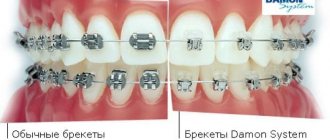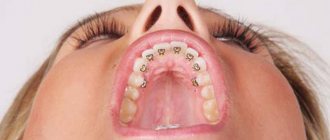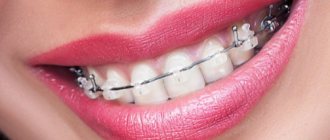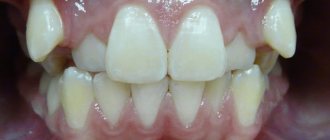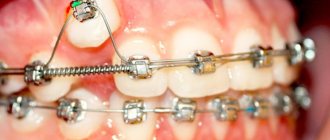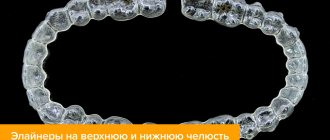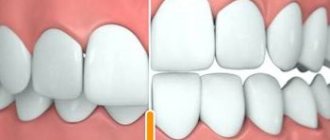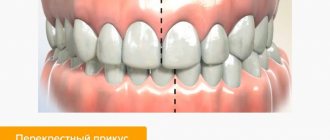Many people hesitate to get braces because they are unsightly. At the same time, they need to be worn for quite a long time - from several months to 2-3 years. Today, the problem of the aesthetics of orthodontic structures is easily solved: with the help of colorless or transparent braces. Let's find out what they look like and what they are.
In this article
- What do clear braces look like?
- Colorless braces: types and features
- Clear plastic braces
- Clear ceramic braces
- Transparent sapphire braces
- Alternative to clear braces
- Hygiene with braces
Wearing braces is the most effective method of treating malocclusion pathologies, which is suitable for almost all people, regardless of the condition of the teeth, age and other factors. Braces are a complex orthodontic structure consisting of many small parts: locks, screws, springs, arches, etc. If they are installed on the outside of the dentition, it is almost impossible to hide them. This is especially true for metal braces.
The aesthetic defect that structures create is one of the main reasons for a person’s refusal of orthodontic treatment. You have to wear braces for a long time: from 6 months to 2-3 years. It will not be possible to hide the presence of staples in the oral cavity from others during this entire time. However, you can still make them less noticeable. For this purpose, colorless or transparent braces are used. Let's tell you why they are called that.
What do clear braces look like?
Braces are made from various materials, including transparent and colorless. They are almost invisible when a person speaks or smiles. In other words, such braces are designed to hide the very fact of orthodontic treatment from other people. However, it is worth understanding that there are no such systems that are completely invisible if they are on the outside of the teeth.
Any orthodontic structure consists of dozens of elements. Locks, screws and other parts that are attached to tooth enamel can be made transparent or colorless. The arc of braces is always metal. She is the one who performs the main bite correction. It is not possible to refuse its installation. But it can be disguised. To make it less noticeable, it is painted white. In such cases, it becomes more aesthetic. However, it cannot be called absolutely invisible: upon closer examination, any interlocutor will notice it, even if he does not look closely.
It is possible to completely hide orthodontic treatment from others. For this purpose, lingual structures and aligners are used. But first, let's talk about transparent braces: their types, advantages and disadvantages.
How is the installation going?
Installation work takes place in several stages. A good dentist takes impressions to make control models in order to further monitor the progress of bite treatment. Then he installs special separation rings that slightly move the teeth apart. The doctor applies an etching gel to the areas where the clear braces are located. After a certain time, it is washed off and the enamel is dried. Then a fixing adhesive bond is applied, which is illuminated with a photopolymer lamp. Glue is also applied to each bracket, after which the orthodontist accurately determines the position of the transparent element, pressing it to the tooth. After the specialist fixes all the braces, he will insert an arch into their grooves, which he will secure with transparent ligatures (rubber bands).
Sapphire braces are much more difficult to fix than metal ones, since they almost merge with the surface of the tooth. Therefore, such systems should be installed only by experienced specialists with extensive practical experience working with transparent orthodontic structures.
Colorless braces: types and features
There are several types of braces that appear clear or colorless:
- plastic;
- ceramic;
- sapphire.
The choice of orthodontic design is limited by medical indications and financial capabilities of the patient. There are cases when it is impossible for a person to get plastic braces, for example, in case of severe malocclusion. Then he can opt for ceramic or sapphire designs. If you don’t have enough money for them, you will have to wear metal braces. Let's describe each variety in more detail.
Lingual braces are the second most popular way to correct malocclusion in adults.
Lingual braces are braces that are fixed to the inner surface of the teeth.
They made a breakthrough in orthodontics, eliminating the main problems of classic braces, gaining a huge advantage over other braces. Which? They became invisible to the outside eye. Then even models appeared that began to be called incognito. If you look at the back, inner side of the teeth with lingual braces installed on them, then we will see the following picture:
Any orthodontic design, no matter how useful it may be, has its pros and cons. This was the case at one time with classic braces, which won the love and hatred of millions, and still stand “guardian of the bite,” bringing considerable benefit to patients. But they were first replaced by their improved competitors, then by invisible, lingual ones, who took away their audience from the classic ones. Then lingual braces began to improve - thinner
, lighter
,
more
invisible
, with combined anti-allergic materials. The trend of progress is clear, right?
At the time of publication - before the start of use in patients, if the number of advantages of the model exceeds the number of disadvantages, then this advantage “in the pluses” allows the bracket system to become popular among orthodontists and patients. But progress does not stand still. And braces are being replaced by competitive technologies, which, by their appearance, seem to bring into view all the disadvantages of their predecessors. And if previously users did not pay any attention to some of the disadvantages of lingual brace systems, their current absence in competitive models forces specialists (orthodontists) and users (patients) to talk about them more and more often. So, what are the advantages and disadvantages of lingual braces are being discussed today.
Clear plastic braces
For the manufacture of plastic transparent braces, special high-quality plastic is used, which can be used in dentistry. Such designs are suitable for both teenagers and adults. Children are especially sensitive to the attention of their peers, so plastic braces are an ideal option for them. Firstly, they can be transparent, that is, almost invisible. Secondly, there are multi-colored models with locks in green, red, yellow, purple or blue. They look fun and stylish, and most importantly - much more attractive than metal products.
Let us list the main advantages of plastic brace systems:
- Aesthetics. The color of the plastic matches the enamel, and is therefore invisible to others.
- Large selection of multi-colored models. This is especially true for teenagers: if it is difficult to make braces invisible, you can make them beautiful and stylish.
- Convenience. A person wearing plastic braces feels more comfortable than wearing metal ones. In addition, the teeth and oral mucosa get used to them faster: plastic braces are lightweight and do not put as much pressure on the dentition as other types of orthodontic structures.
- Low cost. Plastic models are much cheaper than other types of braces.
Plastic structures also have disadvantages:
- They are not suitable for correcting severe malocclusions.
- They darken quickly if you do not follow hygiene rules and diet.
- More fragile and more likely to fail than metal ones.
- It takes longer to correct bite pathology.
Additionally, clear plastic braces are not lingual. They are installed only on the outside of the teeth. If such designs are contraindicated for the patient, and the aesthetic component is important for him, he will have to make a choice in favor of ceramic or sapphire braces.
Aligners - the most transparent orthodontic system
Both ceramic and sapphire braces can only be called transparent. Of course, if you compare them with a metal system, the aesthetics will be much higher. But only Invisalign aligners are truly transparent; they are practically invisible to others even at close range. This is a set of completely transparent removable trays, which the patient independently changes every two weeks.
At the PROPRICUS clinic, experienced orthodontist Natalya Sergeevna Ivanova installs aligners. They always receive rave reviews from patients. All our specialists were trained by the number 1 doctor in the Invisalign rating - Nana Gezalova. We are the only clinic in Moscow that successfully treats with aligners all bite pathologies that braces can handle.
Clear ceramic braces
Ceramic braces are marketed as transparent, but in reality they are more colorless. Sometimes they acquire a slight yellowish or beige tint. Such structures are made from polycrystalline ceramics and aluminum oxide. The doctor can choose a material that imitates the natural color of tooth enamel. The braces will adapt to its shade, becoming almost invisible. However, you can still see them, they are just not as catchy as metal or plastic multi-colored systems.
The main advantages of ceramic braces include the following points:
- There are many shades of ceramics, among which you can choose a model for a specific patient.
- They are resistant to dyes, therefore they do not limit a person’s consumption of coffee, tea and other drinks with dyes.
- They do not cause allergic reactions, as often happens when wearing metal structures.
- Bite pathologies are corrected faster compared to plastic models.
Disadvantages of ceramic systems include:
- They are more expensive than metal and plastic ones.
- They treat pathology longer than metal braces.
- Destroyed during dismantling.
Ceramic staples are also more fragile than metal ones. If a person plays sports and there is a risk of damage to the structure, it is better to install products made of metal or sapphire.
Prices for braces
Consultation with an orthodontist
- X-ray panoramic image
- Oral examination
- Drawing up a treatment plan with costs
Price : 2,000 ₽
*if treatment continues in the clinic according to the plan, the consultation is not paid
| Self-ligating metal braces Damon Q | from 250,000 ₽ |
| Self-ligating ceramic braces Damon Clear | from 250,000 ₽ |
| Aligners - trays for straightening teeth | from 350,000 ₽ |
Prices for system components vary and depend on a number of factors:
- plate material;
- fixation method;
- dental surfaces for attachment;
- dental clinic level;
- the tools used;
- having its own dental laboratory.
By comparing the characteristics , you can determine which braces are best for a particular clinical situation, and which ones are suitable for the patient. The most affordable models are metal ligature models; without ligatures they will be more expensive. The highest cost is for aesthetic systems made of ceramics, sapphire and internal (the most expensive).
The total cost is the fastening mechanism, installation and removal, corrective visits to a specialist, and fastening of retainers. At Implantmaster, the cost of installing the Damon Clear and Q systems, subsequent appointments and corrections will cost around 250 thousand rubles. When choosing orthodontic therapy with the help of aligners (transparent aligners for moving teeth), the price will start from 350 thousand rubles. Diagnostic x-rays, model calculations for the formation of a full course of correction, with further therapy with us, will amount to 2000 rubles, the consultation will be free.
Transparent sapphire braces
Sapphire braces are made from sapphire, obtained artificially in the laboratory. It is much inferior to natural stone in terms of strength, but is superior to other orthodontic systems in this parameter. In addition, sapphire braces are almost invisible. They have the highest aesthetic properties.
List all the advantages of sapphire braces:
- Hypoallergenic. Sapphire is biocompatible with oral tissues, so the likelihood of developing allergies is minimal.
- Fast adaptation. Sapphire braces do not interfere with diction and do not rub the mucous membrane. Getting used to them occurs within a few days.
- High strength. Such structures are resistant to mechanical stress. You can play sports in them.
- The highest aesthetic standards. Sapphire braces are almost invisible. In addition, they do not change their external properties under the influence of food with dyes.
The only disadvantage of such systems is their high cost. Sapphire braces will cost 2-3 times more than metal or plastic structures.
The sixth disadvantage of lingual braces is the intimate side
Doctors are tactfully silent about this drawback of lingual braces. But it exists. And it causes a lot of problems for owners of lingual structures. This is a continuation of the minus of point #3 - injury. But not the tongue - but injury by parts of the internal braces to the mucous membrane of the sexual partner during intimate caresses: causing micro-scratches with possible infection of the wounds due to insufficient hygiene of the lingual braces. Such statistics are periodically published in the European and American press, where they really and openly talk about it.
Alternative to clear braces
Transparent braces made of plastic, ceramic and sapphire can be replaced with conventional metal structures that are installed on the inside of the teeth. Such orthodontic systems are called lingual. Unlike other braces, they are completely invisible.
However, such staples also have disadvantages:
- not suitable for all malocclusion pathologies;
- greatly complicate hygiene procedures.
In some cases, if there is a medical reason for this, the orthodontist may offer the patient aligners (aligners) - orthodontic devices made of plastic and silicone used to correct the bite. They are a plate that is put on the teeth for a certain time. This device corrects the bite by applying pressure to the jaws, just like braces, but the plates are changed periodically to increase the load on the dentition. During treatment, the patient can change several dozen aligners, it all depends on the severity of the pathology.
The aligners are completely transparent, so it is almost impossible to notice them on another person’s teeth. In addition, the aligners can be removed if necessary, for example, before important negotiations or a date.
There are other advantages of aligners: they can be removed before meals, they are easy to care for, there is almost no need to get used to them, etc. But mouth guards are prescribed only for minor bite defects, as well as at the last stage of orthodontic treatment, that is, after removing braces to consolidate the result of therapy.
Price
An important factor when choosing a particular method of correcting a bite is the cost of treatment. Of course, no professional can accurately estimate the final amount that a patient will have to pay for several years of wearing braces. This is due to the fact that the price is formed from many factors; it depends on the frequency of visits to the doctor and the identification of design defects. However, the approximate cost can still be announced:
- Plastic. For installation of the system on one jaw, the bill can be from 20,000 rubles and more.
- Ceramics. Domestic brands will cost a little less than foreign ones. For installation of Smart braces on one row you will pay from 50,000 rubles. More well-known options, for example, from the American manufacturer Ortho, will cost at least 70,000 rubles. per row. At the same time, ligature options cost less.
- Sapphire. Classic devices can cost from 75,000 rubles. and more. Self-ligating ones will cost much more, but the results from their use will be more obvious and faster.
Hygiene with braces
It is impossible to maintain the aesthetic appeal of braces throughout the entire treatment period without following the rules of hygiene. After installation of orthodontic appliances, you will have to brush your teeth more often and for longer than usual. In addition, you will need to buy additional hygiene products. Among them:
- Toothbrush with V-shaped bristles (CURAPROX Ortho).
- Mono-beam brush (CURAPROX 1006 Single & Sulcular).
- Brush (Hager & Werken Miradent Pic Brush Refills Pink).
- Rinses and balms (DRC ROCS “Active calcium”).
- Dental floss (Miradent Mirafloss implant chx).
- Irrigator with attachment for braces (Revyline RL100, Panasonic EW-1411).
You also need to remember your diet. To reduce the risk of damage to the structure and deterioration of its aesthetic properties, it is necessary to avoid solid foods, sweets, sticky foods and a number of other products.
Before purchasing brushes, dental floss, irrigators and other hygiene products, consult your doctor.
What types of braces are there? How long does the installation procedure take? How long should you wear them?
Before invisible braces can be installed, they must be ordered. The production time depends on the manufacturer and type of lingual braces: if you choose standard braces, you will have to wait about 2 weeks for them while the indirect fixation tray is made; if you choose custom braces, it will take 4-6 weeks until they are manufactured and brought from Germany.
What is the difference between custom invisible braces and standard ones?
Individual braces allow you to track the final position of the teeth, that is, see the final picture. Also, the treatment procedure is reduced to 18 months, whereas standard invisible braces must be worn for 2 years. Of course, this mostly depends on the specific situation and only a doctor can give you more detailed dates during the examination. Installing invisible braces is a fairly labor-intensive procedure and takes about 3 hours. After installation, you will also need to visit your doctor periodically to check and adjust the system.
Motivation for orthodontic treatment is different for men and women
Regular surveys of adult patients who are considering certain methods of correcting their bite show that men and women motivate themselves differently against braces. But the basis for refusing treatment with lingual braces is their two disadvantages - discomfort
and
price
.
Men speak directly about the discomfort of braces: “Am I a boy, or what?”
Women reduce the problem of wearing braces to a psychological level, preferring aligners:
What lengths do aligner manufacturers now go to in order to divert patients' attention from braces?
There are good discounts, free consultations, and even free modeling of a future smooth and beautiful smile. But most people, out of established habit, choose not even lingual braces, but ordinary braces, as the main way to correct their bite. In any case, whichever method you choose now, this is the first step towards solving the problem of crooked teeth and entering a new world of opportunities that will open up your beautiful smile.
And by the way, you can sign up for a free consultation and 3D smile modeling in your city by filling out the form below this article. Star Smile specialists will select a specialized orthodontic center for you in close proximity to your residence.
Disadvantages of invisible braces
Of course, any brace system, even invisible, has its own characteristic disadvantages. These include:
- Inconspicuous braces compared to standard ones can create some problems with diction. But this disadvantage quickly goes away as soon as adaptation ends.
- Technical difficulties when installing an invisible structure. This requires professionalism and extensive experience as a doctor in this field. In addition, the patient will have to be more careful in cleaning and caring for the braces.
- High cost of the product. Among all the available varieties, hidden braces are considered the most expensive.
Why are aligners cheaper than lingual braces?
Both external and internal braces are being replaced by digital technologies in the form of aligners, which are comfortable, invisible and completely predictable. If in the case of lingual systems orthodontists note as a plus such aspects as 3D visualization and the ability to at least partially control the process of correcting the bite, then in the case of aligners the patient ALWAYS sees his result BEFORE the start of treatment and this result is always achieved in 100% of cases.
And of course, a big question arises about the price of lingual systems. As we said just above, lingual braces are the MOST expensive way to correct a bite. And if we consider the same Star Smile aligners as a method of treatment, then the cost of treatment with aligners over the last year has become much lower than the cost of this type of braces.
Why did it happen? Everything is very simple. Where during the treatment process the orthodontist spends his time (which is very expensive for them) carefully considering the method of moving the tooth and correcting the bracket system, in the case of aligners, the entire treatment prognosis was planned in advance by the software. And the doctor’s participation in correcting the bite using aligners becomes less. And the result is almost the same!
Aligners
Aligner trays are made from special types of silicone with high transparency and specially specified parameters of flexibility and elasticity. They are removable systems that must be removed during every meal and brushing of teeth. In addition, they also need to be cleaned from time to time using toothpaste. Their main advantages over other systems are high elasticity, efficiency and comfort. They are able to follow the contours of your gums and teeth as accurately as possible, so you will not experience any discomfort when wearing them.
What to choose
Each of the described brace systems allows you to effectively combat malocclusion, both mild and complex types. As for the choice, it is difficult to single out just one type of design. There are a number of factors that need to be taken into account, one of which is price.
If you adhere to the opinion of doctors, then they recommend sapphire and ceramic braces that are not visible. But objectively, lingual products are the best. Despite the fact that they have a very high cost, today they are preferred by those patients who are constantly in contact with people. If what is more important to you is not appearance, but convenience, then you should opt for sapphire designs.
And now - about the competitor of lingual braces
Who has become a competitor to lingual braces? Who has opportunities that are not available in lingual constructions? These are orthodontic aligners, the so-called aligners (aligners in English are “aligners”). The beginning of a new era in orthodontics was heralded by Invisalign. With the advent of aligners, the world was divided into two diametrically opposed camps - “with braces” and “without braces”. And no one from the “braces” camp wants to give up their place on the podium. But new aligner technologies based on mathematical models of the movement of teeth and their nerve endings in the gums, improving computer technologies for modeling treatment results, reducing the influence of the human factor in making certain decisions on the tactics of patient management - step by step, are confidently pushing back braces. which cannot compare anything new to aligners. And what is the result?
By the way, if you have 1 minute and are ready to answer 9 express questions
, you can find out whether aligners are right for you or not.
But let's continue about lingual braces
Do you think that lingual braces only have the five disadvantages that we discussed above? Unfortunately no. Orthodontists have prepared a large comparative analysis of bite correction systems - on the one hand - albeit invisible, but - rigid bulky structures such as braces, and on the other - orthodontic aligners, aligners (they are generally weightless and invisible on the teeth). This analysis also included all the pros and cons of lingual braces. There are more than 70 of them (!). And if you read this analysis in detail - and it is really interesting and written in simple language, then you get the feeling that not only lingual braces, but all braces - although they are popular, they are already a thing of the past, as they say.
In what cases are internal braces not used?
For a number of clinical cases, invisible braces are the best treatment option. For example, lingual braces for deep bites work much more effectively than vestibular braces. However, there are a number of restrictions under which it is better not to place lingual braces on teeth. Among them:
- periodontal diseases;
- low dental crown;
- dysfunction of the temporomandibular joint;
- allergy to the materials from which the system is made;
- bruxism;
- too narrow jaw;
- severe crowding of teeth;
- age under 11 years.
Design features.
The duration of treatment takes on average from 1 to 3 years. Therefore, during this time a person should not be confused or disturbed by the presence of the system. Therefore, metal braces are not suitable for everyone. Although they are considered the most reliable way to correct the position of teeth, their massiveness and unpleasant shine repel people. There is an alternative to metal, and it is ceramics. This material has high aesthetic values, matches the shade of the enamel, becoming “invisible” to others.
The design of braces consists of several main elements:
- Plates. They are fixed to the enamel surface using special glue. An individually made bracket is designed for each tooth.
- Orthodontic arch. It creates pressure, which causes the teeth to move. Passes through each plate, connecting them together with each other.
- Ligatures. Used in the classical vestibular system. Perform the function of fastening between the arch and braces. Over time, they change color under the influence of coloring products, so they have to be constantly replaced with new ones.
- Locks. Used in self-ligating construction. Thanks to them, bite correction is more effective and faster. Each plate has a special lock that firmly holds the arc.
Important! Only a dentist can determine which type of orthodontic system is right for you, after carrying out diagnostic measures. Since in some cases only metal staples can help.
Indications and absolute contraindications.
Treatment with clear braces is applicable for patients of different ages. They cope well with their tasks, forever relieving people of congenital and acquired dental anomalies. With their help you can solve various kinds of problems:
- Crowding.
- Wide interdental gaps.
- The need for a preparatory stage before installing prostheses.
- Deformations of individual units.
Correction with this device is not always possible due to the presence of certain diseases in humans. In this case, its use may cause damage to teeth.
Absolute contraindications include:
- Completely edentulous.
- Pathologies of the skeletal system.
- Diabetes.
- Oncology.
- Mental disorder.
- Problems with blood clotting.
- Endocrine or immune diseases.
